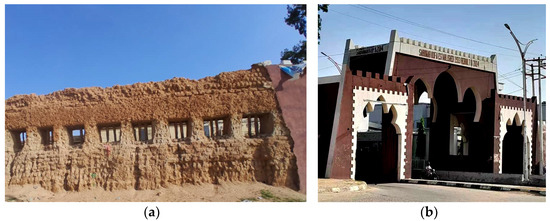1. Cultural Heritage Sites in Kano, Nigeria
In most cities of the developing nations, using Nigeria as a model, the drastic increase of economic routine and quest for prime land in the metropolitan areas threaten the survival of aging reserved monument sites. It has as well been noted that natural and cultural heritage are ever more endangered through devastation by the traditional causes of decay and by transforming social and economic circumstances which intensify the situation of this stock with the phenomena of destruction and damage [
16,
17].
Cultural heritage in Kano is visible from the perspective that the ancient city is sheathed by the fortification wall, having three local administration expanses known as Dala, Gwale, and the Kano Municipal. The Kano Emirate in the eleventh century was a fundamental piece of the world economy, specifically in Africa, bringing together different commercial goods such as cowhide, iron, and cotton materials to mention but a few. As a result of the blow-up in the Nigerian economy and periodic growth in the number of inhabitants, Kano city could not accommodate strangers, which necessitated protecting the city and further encouraged the building of city walls to safeguard the residents from attack [
15].
The old Kano cultural landscape has a compositional layout and a fortunate story that pulls in universal interest in the city. As portrayed in
Figure 1, Kano is the greatest enduring stronghold of many cultural sites and events in the west of Africa. Adamu [
15] further asserts that the Kano walls were founded based on the vigor of winning wars. The erection of these walls commenced with the work of Sarki Gijimasu in 1100 AD, and was carried on by Sarki Mahammadu Rumfa (1463–1499), Sarki Mahammadu Nazaki (1618–1623), and in 1834–1937 there was further opening out to allow development. These walls were pronounced national landmarks in 1959, with the National Commission for Historical Centers and Landmarks being in control [
15].
Figure 1. Kano Durbar, an annual festival. Source: Authors’ Fieldwork, 2021.
Kano city’s cultural sites were recorded by UNESCO among world heritage sites in its tentative list [
15]. They further emphasized that, in 2007, the National Commission of Museums and Monuments (NCMM) are responsible for the protection of the Emir of Kano’s royal palace, revealing the UNESCO world heritage order of the city’s revitalized walls, royal residence, and other prominent places. Over a decade of such acknowledgments by UNESCO, action on the proposal remains immobile and history specialists are alarmed that the unrelenting harm to the strongholds could put in them further danger. The remaining fractions of the revitalized walls of Kano are more imperilled with devastation than at any time in the modern era because of civic strategies that give little concern to heritage conservation. Below are some of the historic sites in Kano.
- a.
-
City wall and gates: the gates which have 15 doors, as reviewed, entail 8 traditional entryways (erected with mud), 6 modernized doors (reconstructed in concrete), and 1 present-day door (ongoing project with concrete). Nevertheless, the Kano city wall remains a good-natured declaration of African indigenous deployment of its engineering to distinguish political space, as a safeguard and defence structure, a working alliance, and the executive, to mention a few (see Figure 2).
- b.
-
Kurmi Market was the foremost and principally recognized marketplace that has been in existence as long as the old Kano city. Its planning was astounding and innovative in the engineering development in the design of the market layout. While investigation reveals that it was rarely conserved, relatively it has undergone a few transformations to the level that it has mislaid its historic signature to unnecessary modernism [
13].
- c.
-
Kano Emir’s Palace was founded by the Emir of Kano, Sarki Muhammadu Rumfa, who ruled from 1463 to 1499. The palace has three doorways, to be precise
Kofar Fatalwa,
Kofar Kwaru,
and Kofar Kudu (shown in
Figure 3). The palace is divided into three fragments; the administrative structure with spaces (Rumfar Kasa, Soran Zauna Lafiya, Soron Bello, and Soron Giwa) is situated in the south. The focal fraction entails the Emir’s family while the northern parts remain for the servants’ and workers’ quarters [
15].
Figure 2. (a) Eroded part of the ancient Kano city wall. (b) One of the rehabilitated city gates in 2014. Source: Authors’ Fieldwork, 2023.
Figure 3. Kofar Kudu, one of the prominent entrances of the Emir’s Palace in Kano. Source: Authors’ Fieldwork, 2023.
2. Contemporary Methodologies for the Conservation of Architectural Heritage
Inventive technologies have been used in the conservation of heritage buildings around the world with proven efficacy [
18,
19,
20]. These methods include documentation, diagnostic, and treatment, where many of the techniques have proved to be non-destructive and productive.
The non-destructive techniques of heritage conservation make it possible to achieve the quantitative and qualitative aspects required for heritage buildings’ preservation, though such techniques can be elusive and time consuming [
21]. Moreover, conservation procedures are classified into three [
21,
22,
23,
24] as highlighted below.
Figure 4 shows the details of different techniques required for the conservation of architectural heritage.
Figure 4. Innovative methodologies in preservation and restoration.
2.1. Documentation Techniques
Documentation techniques include surveying heritage buildings and recording the elements required for visualization of the reflected subject to be handed to the conservationist. Such documentation methods entail observation, recording, and unveiling the data [
7]. Documentation is, simply put, recording and visualization methods [
22] (see
Figure 4). Ref. [
25] considered the image-based scheme as limited and purposely meant to capture and store only the photographic data. A combinative process, on the other hand, benefits from both image and non-image-based schemes, and, therefore, is a better option.
Furthermore, conservation processes require an understanding of the authenticity, value, and significance attached to the emotional as well as the physical characteristics of the heritage entity [
26]. Gathering information on the physical conditions such as the state of the materials is, therefore, essential; it also includes examining the microstructure, chemical constituents, and morphological characteristics of the built heritage [
25].
2.2. Diagnostic Methods
A diagnostic method involves examining the recorded deficiency for further treatment of the deterioration and decay.
Research by [
21,
27] unveiled the integrated and multiple ideas in the diagnosis of a putrefied built structure. The use of a three-dimensional terrestrial laser scanner was applied to examine the classification, origin, development, and history of the stone utilized in the construction, an ultrasonic measurement verified the stone size to find out the elasto-mechanical strength. Infrared thermography was used to examine the temperature of the built heritage through its surface. Scanning electron microscopy (SEM) and optical microscopy (OM) were used to potentially reveal the porosity, type of stone, and existence of microbes. SEM and OM can differentiate materials, identify possible biodeteriogens, and demonstrate the space and surface allotment of possible biodeteriogens [
19,
24]. Material classification provides the possible type of stone applied in the construction, its pore size and grain size, all of which authenticate the exposure of heritage buildings to deterioration [
27,
28].
Non-invasive and non-destructive methods are used to perform diagnosis, as highlighted by [
29]. They [
29,
30] also emphasized that these techniques do not destroy the underlying material, which makes them advantageous. The materials used in these methods include nitrocellulose membranes [
31], adhesive tapes [
32], and sterile scalpels [
33].
A Raman spectrometer was primarily used in the previous conservation works, but often does not have the proper report for the treatment carried out. This makes it unique in its potential to recognize the conservation executed [
34,
35]. It is often selected for in situ analysis when finding out the organic and inorganic subject on a stone bedrock. X-ray diffraction verifies the structure of natural compounds and the nature of a crystalline compound as well [
36]. Nevertheless, it is avoided in some cases because of its destructive nature [
7].
Some novel molecular-based diagnostic methods adopted in cultural heritage preservation include omics: genomics and proteomics. Genomics provides information on microorganisms that live in deteriorated heritage, as well on the biodeteriogens living on the heritage site [
32,
37,
38]. Ref. [
39] emphasizes the application of this method as it illustrated the array of microbes on stone monuments surrounding the UNESCO world heritage site at the West Lake Cultural Landscape of Hangzhou, where cyanobacteria were discovered as the likely biodeteriogens. The use of proteomics before conservation work is of assistance since it recognizes organic binders applied in paintings on a heritage substance or earlier conservation treatments [
40]. A Fourier transform infrared (FTIR) spectrometer recognizes organic and inorganic materials (in some cases) while sodium dodecyl sulphate→polyacrylamide gel electrophoresis (SDS→PAGE) isolates and recognizes the specific protein available in the organic substance.
Conservation of architectural heritage begins with an appropriate examination of the building and structural components to establish the basis of the degradation and its extent alongside the proper conservation treatments to be applied [
41,
42]. The initial evaluation is through physical inspection, in which conservationists with architects assess the decay visually, without devices. Even though this is a necessary step, it does not provide specific information concerning the history or decomposition in progress, for this reason, the call for informative diagnostic tools and skills are essential.
Nevertheless, proteomics is the best technique due to its productive act on the conservation of painted built heritage in Nigeria, because of its novel recognition of organic binders applied in paintings on a heritage substance or earlier treatments’ interventions.
2.3. Treatment Interventions
There are many approaches to the restoration of the built heritage with treatment intervention methods [
7]. Nanotechnology methods have been broadly utilized in the conservation of built heritage as consolidants [
43], cleaning agents [
18], and biocides [
44]. The biocides were implanted in a tetraethyl oxysilane (TEOS), water-repellent consolidant, and/or siloxane-based substance; Estel 1100, SILO III, and TEOS are nanocomposite materials which consolidated the weathered stone [
7]. Ref. [
45] further noted that it builds up a copper polymer organo-composite that has bacteriostatic and antifungal actions that were discharged slowly for a certain time.
Biotechnology, in the context of the restoration of cultural heritage, has been popular for more than ten years [
46] and also has been used in developed nations [
47]; however, it is yet to be implemented in Nigeria [
7]. The benefit of biorestoration over many traditional treatments lies in its harmlessness to professionals, its eco-friendliness, non-destructiveness, precision, and efficiency [
48].
Hence, the advanced techniques in the conservation of cultural heritage include nanotechnology, bio-conservation (biotechnology), and laser technology, among others, which are used due to their efficiency, safety, and ecological nature.
This entry is adapted from the peer-reviewed paper 10.3390/buildings13081899




